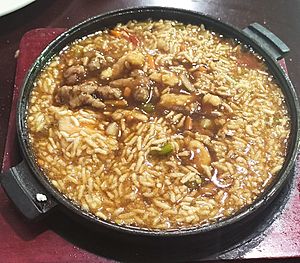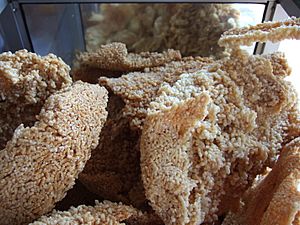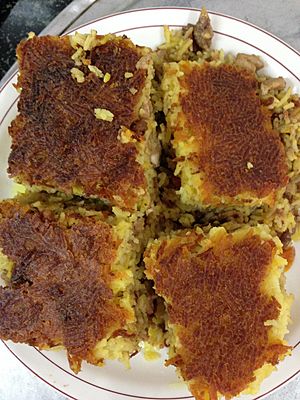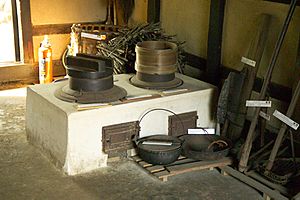Scorched rice facts for kids

Scorched rice in Iran
|
|
| Alternative names |
List
pegao - Puerto Rico
concón - Dominican Republic concolón - Peru, Ecuador, Panama cocolón - Colombia, Venezuela gratén - Haiti cucayo – the Caribbean htamin gyo (ထမင်းချိုး) - Burmese kerak nasi – Indonesian kaning tutóng – Filipino cơm cháy – Vietnamese guōbā (锅巴(s); 鍋巴(t)) – Mandarin Chinese faan6 ziu1 (饭焦(s); 飯焦(t)) – Cantonese Chinese nurungji (누룽지) – Korean okoge (お焦げ) – Japanese qazmagh ((Azeri)) or qazandibi ((Azeri))– Azerbaijani bnkr (Template:Ku) – Kurdish hakakeh ((Arabic)) - Iraqi Arabic kodada ((Arabic)) - Hejazi Arabic arae el halla ((Arabic)) - Egyptian Arabic socarrat - Valencian and Catalan kanzo or ɛmo ase - Twi mawowó - Makhuwa kokorota - Cape Verdean Creole |
|---|---|
| Type | Cooked rice |
| Main ingredients | Rice |
| Variations | Cucayo, guōbā, nurungji, okoge, tah dig, rengginang |
Scorched rice, also known as crunchy rice, is a thin layer of rice that turns slightly brown at the bottom of a cooking pot. It forms when rice is cooked over direct heat, like from a flame. Many cultures around the world enjoy this crispy part of the rice.
Contents
- Varieties of Scorched Rice
- Scorched Rice in Cape Verde
- Scorched Rice in China
- Scorched Rice in Colombia
- Scorched Rice in Ghana
- Scorched Rice in Indonesia
- Scorched Rice in Iran
- Scorched Rice in Iraq
- Scorched Rice in Japan
- Scorched Rice in Korea
- Scorched Rice in Latin America
- Scorched Rice in Myanmar (Burma)
- Scorched Rice in the Philippines
- Scorched Rice in Spain
- Scorched Rice in Vietnam
- See also
Varieties of Scorched Rice
Scorched Rice in Cape Verde
In Cape Verdean Creole, the crunchy rice at the bottom of the pot is called kokorota. People traditionally cook it outdoors or in a special cooking area. They use a three-legged metal pot over burning firewood.
Today, many people in Cape Verde use gas stoves and modern pots. However, the traditional three-legged pots are still popular in rural areas. They are also used for big parties or festivals when a lot of food is needed.
Scorched Rice in China
In China, scorched rice is called Guōbā (simplified Chinese: 锅巴; traditional Chinese: 鍋巴; pinyin: guō bā; literally "pan adherents"). Sometimes it's known as mi guoba (米鍋巴, lit. rice guoba). It forms when rice is boiled over a flame, creating a crispy crust at the bottom of the wok or cooking pot.
This scorched rice is firm and crunchy. It has a slightly toasted flavor and is sometimes eaten as a snack. Guōbā is also used in many Chinese dishes with thick sauces. Its mild taste soaks up the flavors of the sauces. It's also served in soups and stews, especially in Sichuan cuisine.
Since electric rice cookers don't usually make guōbā, it is now made in factories. This helps meet the high demand for it. In Hong Kong and other Cantonese-speaking areas, scorched rice is called faan6 ziu1 (飯焦, lit. rice scorch).
Scorched Rice in Colombia
In Colombia, the crunchy rice at the bottom of the pot is known as la pega (which means "the glue").
Scorched Rice in Ghana
In Twi, scorched rice is called kanzo or ɛmo ase. This means "bottom of rice." It usually happens by accident when rice burns a little while cooking. Some people throw it away, but many others enjoy its crunchy texture.
Scorched Rice in Indonesia
In Indonesian cuisine, especially in Central Java, scorched rice is called intip. It's a special snack from the Wonogiri Regency area. This rice cracker is made from the hard, slightly burnt rice that sticks to the bottom of rice-cooking pots.
To make intip, water is added to the cooking pot to loosen the stuck rice. Once separated, the rice is dried in the sun until it's completely dry. Then, this dried sticky rice is deep-fried until it becomes a crispy cracker.
Indonesia also has a similar rice cracker called rengginang. However, rengginang is different from intip. It's not made from scorched rice. Instead, it's made from steamed sticky rice that is boiled, seasoned, shaped into flat rounds, and sun-dried before being deep-fried.
Scorched Rice in Iran
In Iran, scorched rice is called tahdig. It is a very important part of cooking rice there. Tahdig (Persian: ته دیگ, tah "bottom" + dīg "pot") is a special part of Iranian cuisine. It is a crisp, golden layer of rice from the bottom of the pot where the rice (chelow) is cooked.
Tahdig is often served to guests. People sometimes add ingredients like yogurt and saffron, bread, or potato to the bottom of the pot to make different kinds of tahdig. They can also use vegetables like carrots or lettuce. Iranians also make a crispy base when cooking spaghetti.
Scorched Rice in Iraq
Iraqi rice cooking involves several steps to make soft, fluffy rice. A key part of Iraqi rice is the hikakeh, which is the crisp bottom crust. The hikakeh also has some loose rice mixed in. Before serving, the hikakeh is broken into pieces so everyone gets some with their fluffy rice.
Scorched Rice in Japan
Okoge (お焦げ, おこげ) is a Japanese food, usually rice, that has been slightly burned or scorched.
Before electric rice cookers became common, people in Japan cooked rice in a kamado. This was a traditional stove heated by wood or charcoal. It was harder to control the heat, so a layer of rice at the bottom of the pot often got a little burned. This layer, called okoge, was not thrown away. People ate it with vegetables or mixed it with water, soup, or tea.
Okoge is still eaten in Japanese cuisine today. It's an important part of the kaiseki meal served at tea ceremonies. There, it's usually the last course, served with hot water and pickles. It has a crispy texture and a nutty flavor.
Modern electric rice cookers control the temperature very well, so okoge doesn't usually form naturally. However, some rice cookers in Japan have an okoge setting. You can also make okoge by scorching cooked rice in a frying pan.
Scorched Rice in Korea
Nurungji (누룽지) is a traditional Korean food made from scorched rice. After boiling and serving rice, a thin crust of scorched rice often remains at the bottom of the pot. This yellowish, scorched state is called nureun (눌은) in Korean, and nurungji comes from this word.
Nurungji can be eaten as a crispy snack. You can also add hot water to it to make sungnyung (scorched rice tea). Or, you can reboil it with water to make nureun bap (눌은밥) or nurungji bap (누룽지밥). Nurungji can also refer to the crispy crust that forms when cooking other rice dishes, like dolsot bibimbap (돌솥 비빔밥) and bokkeumbap.
Nurungji is traditionally believed to have health benefits. An old medical book from the 17th century, Dongui Bogam, said nurungji was a remedy for upset stomachs. It is still seen as a healthy food in South Korea.
Around the mid-2000s, South Korean companies started selling nurungji in different packaged forms. Besides sweet fried nurungji snacks and instant nurungji for nureunbap, many nurungji-flavored products were made, like candies and tea. Nurungji is also used in new dishes, such as nurungji baeksuk and nurungji pizza.
Nurungji is often mentioned in Korean folk tales and songs. A famous folk song changes the words of the Thousand Character Classic to a clever rhyme that means: "sky cheon (天), earth ji (地), nurungji in the gamasot (cauldron pot)." (Korean: "하늘 천, 땅 지, 가마 솥에 누룽지").
Scorched Rice in Latin America
Scorched rice has many names in the Caribbean and Latin America. It's called cucayo, pegao, cocolón (Ecuador), concolón, raspa, raspado, graten (Haiti), bunbun (Jamaica), and concón (Dominican Republic).
In Colombian cuisine, it's called cucayo, pega, or pego. People often eat it with vegetables, like a cracker, or serve it in soups. It can also be eaten alone or used with leftover food. In Dominican cuisine, it's called concón. This word can also mean the crunchy, toasted bottom of other foods.
In Puerto Rican cuisine, scorched rice is called pegao (short for "pegado," meaning "stuck"). In Ecuador, kukayu (cucayo) is the name for food taken on a trip. This comes from the Quechua word kukayu, meaning a portion of coca. In Trinidad and Tobago cuisine and other English-speaking Caribbean countries, scorched rice is called bun bun.
Scorched Rice in Myanmar (Burma)
In the Burmese language, scorched rice is called htamin gyo (ထမင်းချိုး). It is often found in hsi htamin, which is sticky rice cooked with turmeric and oil.
Scorched Rice in the Philippines
Tutong (Tagalog) or dukót (Cebuano, meaning "to stick") is used in many dishes in Filipino cuisine. It can even be used to flavor ice cream. Some people might see it as a "poverty food," but others eat it because they enjoy the taste.
Scorched Rice in Spain
Socarrat (in Valencian and Catalan Spanish) refers to the crispy crust that forms at the bottom of the pan when cooking paella. In Castilian Spanish, it is also known as Churruscado.
Scorched Rice in Vietnam
In Vietnamese cuisine, scorched rice is called cơm cháy (which means "scorched rice"). It is usually fried in oil until it turns golden brown. Then, it's topped with chà bông (pork floss) or tôm khô (dried shrimp). It also gets mỡ hành (chopped scallions cooked with hot oil to release their smell) and chili paste. This makes a popular dish called cơm cháy chà bông or cơm cháy tôm khô. Sometimes, both pork and shrimp are used.
Cơm cháy can be made from the rice crust left in an iron pot after cooking. More often now, since electric rice cookers are common, it's made from leftover cooked rice that is fried in oil over high heat to make it crispy.
See also
 In Spanish: Cocolón para niños
In Spanish: Cocolón para niños






